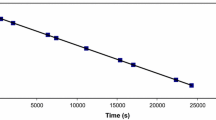Summary
The property-specific ligand control of 28 ligands on the decomposition temperatures in solution, measured by d.t.a. of a four-coordinate nickel(II)-complex is reported. A quantitative separation of electronic and steric effects by a multilinear regression analysis (75% electronic and 25% steric influence for the chosen ligands) is presented. The controlling effect of the selectivity on the decomposition (fraction of the C-C-linked product) (25 P-ligands) leads to an electronic: steric ratio of the property-specific ligand control of 55∶45 for the chosen ligands. An increase in the relative acceptor character of the P-ligands relatively destabilizes the complexes and thereby favours formation of a C-C-bond. An increase in steric hindrance also favours C-C-bond formation. A method for revising the steric parameter of P-ligands is presented and is used to correct the Θ-value of (PhCH2)3P is corrected to 135°. SCCC-MO-calculations for testing the chemical reasoning of the separated electronic and steric ligand property control are shown.
Similar content being viewed by others
References
Organometallic complex compounds, Part 5: R. Berger, H. Schenkluhn and B. Weimann,Transition Met. Chem., 5, 272 (1981).
C. A. Tolman,Chem. Rev., 77, 313 (1977).
H. Schenkluhn, W. Scheldt, B. Weimann and M. Zähres,Angew. Chem. Int. Edit. Engl., 18, 401 (1979).
P. Heimbach, J. Kluth, H. Schenkluhn and B. Weimann,Angew. Chem. Int. Edit. Engl., 19, 569 (1980).
L. P. Hammett,Chem. Rev., 17, 125 (1935); R. W. Taft,Steric Effects in Organic Chemistry, Wiley, New York, 1956.
P. Heimbach and H. Schenkluhn,Topics in Current Chem., 94, 45 (1980);ibid, p. 102.
R. Berger, J. Kluth and H. Schenkluhn,Proc. Int. Conf. Phosphorus Chem., Sept. 17–21, 1979, Abstr. of Papers III, 342 (1979), Halle (Saale), GDR.
E. Koch,Chem. Ing. Tech., 37, 1004 (1965).
G. Hermann,Dissertation, TH Aachen 1963.
H. H. Karsch, H. F. Klein and H. Schmidbauer;Angew. Chem. Int. Edit. Engl., 14, 637 (1975).
H. Schenkluhn,Dissertation, University of Bochum, (1971).
W. A. Nugent and J. K. Kochi,J. Am. Chem. Soc., 98, 273 (1976).
F. Krech and A. Zschunke;Z. Anorg. Allg. Chem., 440, 45 (1978); F. Krech and K. Issleib,ibid., 425, 209 (1976).
T. Yamamoto, A. Yamamoto and S. Ikeda,J. Am. Chem. Soc., 93, 3350 (1971).
B. L. Barnett and C. Krüger,J. Organometal. Chem., 77, 407 (1974).
F. Brille, J. Kluth and H. Schenkluhn,J. Mol Catal., 5, 27 (1979).
C. A. Tolman,J. Am. Chem. Soc., 92, 2956 (1970).
A. Immirzi and A. Musco,Inorg. Chim. Acta, 25, 241 (1977).
J. D. Smith and J. D. Oliver,Inorg. Chem., 17, 2585 (1978).
G. Ferguson, P. J. Roberts, E. C. Alyea and M. Khan,Inorg. Chem., 17, 2965 (1978); E. C. Alyea, S. A. Dias, G. Ferguson and M. Parvez,Inorg. Chim. Acta, 37, 45 (1979).
L. E. Manzer and C. A. Tolman,J. Am. Chem. Soc., 97, 1955 (1975).
W. C. Trogler and L. G. Marzilli,J. Am. Chem. Soc., 96, 7589 (1974);Inorg. Chem., 14, 2942 (1975).
B. E. Mann, C. Masters, B. L. Shaw, R. M. Slade and R. E. Stainbank,Inorg. Nucl. Chem. Lett., 7, 881, (1971).
F. Brille, P. Heimbach and H. Schenkluhn, unpubl. results; see ref. 6, p. 102.
M. Wolfsberg, L. Helmholtz,J. Chem. Phys., 20, 837 (1952).
Recent review articles about applications of the EH-MO method, see: T. A. Albright,Trans. Am. Crystallogr. Assoc., 16, 35 (1980)
D. M. P. Mingos,Trans. Am. Crystallogr. Assoc., 16, 17 (1980).
F. D. Mango, J. H. Schachtschneider, Catalysis of Symmetry Forbidden Reactions, in G. N. Schrauzer (Ed.),Transition Metals in Homogeneous Catalysis, New York, 1971.
H. Basch, A. Viste and H. B. Gray,J. Chem. Phys., 44, 10 (1966).
J. W. Richardson, W. C. Nieuwpoort and R. R. Powell,J. Chem. Phys., 35, 1057 (1962);J. Chem. Phys., 38, 796 (1963).
E. Clementi and D. L. Raimondi,J. Chem. Phys., 38, 2686 (1963).
Author information
Authors and Affiliations
Rights and permissions
About this article
Cite this article
Schenkluhn, H., Berger, R., Pittel, B. et al. Organometallic complex compounds, part 6(1). Property-specific ligand control of stability and reactivity of (1,3-dimethyl-η3-allyl)methylnickel-ligand complexes. Separation of electronic and steric effects. Transition Met Chem 6, 277–287 (1981). https://doi.org/10.1007/BF00620746
Received:
Revised:
Issue Date:
DOI: https://doi.org/10.1007/BF00620746




